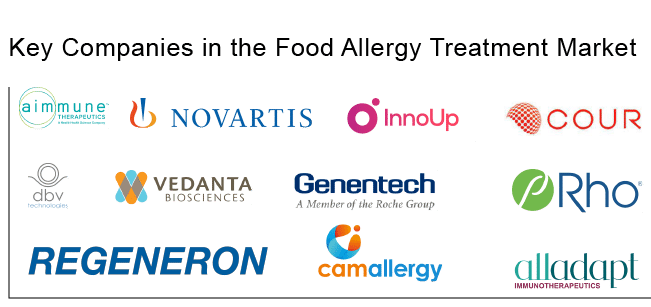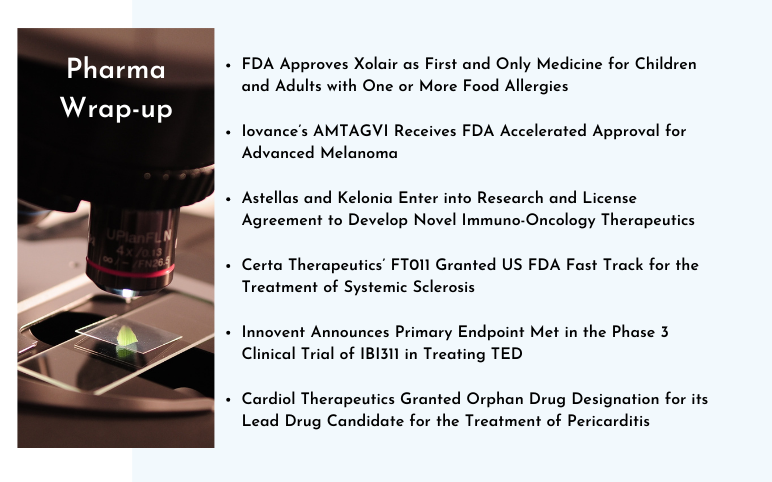Most Promising Therapies in the Food Allergy Treatment Market
May 09, 2022
Table of Contents
Food allergies are becoming a global concern. According to the World Allergy Organization, “food allergy impacted around 2.5% of the general population, but prevalence figures ranged from 1% to 10%.” The increasing incidence of food allergies is raising food safety and public health issues and it is estimated that 4%-6% of children and 4% of adults in the United States are afflicted by various food allergies.
Food allergy symptoms are more frequent in infants and children, but they can occur at any age. Individuals even acquire a food allergy that they have consumed without no problem for years. The most severe allergic reaction is anaphylaxis, a potentially fatal whole-body allergic reaction that can limit breathing, produce a significant decrease in blood pressure, and affect the heart rate.
Downloads
Click Here To Get the Article in PDF
Recent Articles
- Neurotech’s ENCELTO Becomes First FDA-Approved Treatment for MacTel Type 2; Plus Therapeutics’ Rh...
- What are the Top 9 Most Common Food Allergies and How Pharma Companies are Tackling the Crisis?
- FDA Approves Xolair for Food Allergies; FDA Accelerated Approval for Iovance’s AMTAGVI; Astellas ...
- 8 Of The Most Common Foods Allergies – Do You Have One?
- Dupixent Significantly Reduced COPD Exacerbations; Sosei Heptares to Regain Ownership of GSK43814...
Food allergy diagnosis are based on the patient’s history and physical exam. The most common Food Allergy diagnosis methods are Skin Prick Tests (SPT), which is the preferred Food Allergy testing method in patients; double-blind placebo-controlled food challenge (DBPCFC), which is the preferred food allergy test for diagnosis. In addition, in vitro diagnostics can help identify cross-reactive allergens between pollen and foods or foods and latex, and the Atopy Patch Test (APT) is an epicutaneous skin food allergy test that employs allergens often linked with IgE reactions. Moreover, food allergy testing is performed to determine whether an adult or children is allergic to a certain food. Food allergy testing also be used to find out whether the person is allergic to food or sensitive.
Browse through our blog section to learn more about Common Food Allergies
Food Allergy Market Insights
Food allergy treatment depends on avoiding the foods to which an individual is allergic as a therapeutic intervention (tertiary prevention) in individuals with food allergy. Despite best attempts at food allergy treatment, serious responses such as anaphylaxis can occur. The first-line food allergy therapy for anaphylaxis is epinephrine. Additional food allergy drugs include H1 and H2 antihistamines, corticosteroids, and prostaglandin synthetase inhibitors. These food allergy medicines are simply symptomatic and do not alter the normal course of the disease. Immunotherapy may result in desensitization and a lower chance of severe responses following accidental consumption of an allergen, resulting in an enhanced quality of life.
PALFORZIA, developed by Aimmune and bought by Nestle in October 2020, is the first FDA-approved food allergy treatment. PALFORZIA was approved as oral immunotherapy (OIT) on January 31, 2020, by the FDA for the mitigation of allergic reactions, including anaphylaxis, that may occur with accidental peanut exposure for patients aged 4 to 17 years with a confirmed diagnosis of peanut allergy. On December 17, 2020, this food allergy drug received the approval from the European Commission (EC), whereas on April 7, 2021, by the Medicines and Healthcare products Regulatory Agency (MHRA) in the U.K., and on May 4, 2021, by Swissmedic for the food allergy treatment.
Recently, Aimmune Therapeutics announced in February 2022 the publication of new clinical data from a pooled analysis of three controlled Phase 3 (PALISADE, RAMSES, ARTEMIS) and two open-label extension food allergy clinical trials (ARC004, ARC011) of PALFORZIA® [Peanut (Arachis hypogaea) Allergen Powder-dnfp] trials in the Journal of Allergy and Clinical Immunology.
Furthermore, the Food Allergy treatment market dynamics are anticipated to change in the coming years as global food allergy prevalence is rising tremendously, and so does the demand for novel and effective food allergies treatments. According to DelveInsight, the Food Allergy market size in seven major markets is estimated at USD 1,043 Million in 2019 and is expected to reach USD 6,125 Million by 2032 at a CAGR of 14.59%. The United States will account for the largest market size amongst the 7MM during the forecast period [2022–2032] compared to Japan, and EU5. Among EU5 countries, Spain will generate the highest amount of revenue, followed by Italy, while UK will occupy the bottom of the ladder.
Furthermore, the launch of various multiple-stage pipeline products in food allergy clinical trials will significantly revolutionize the food allergy treatment market dynamics shortly.
Emerging Therapies in the Food Allergy Treatment Market

Several pharmaceutical food allergies companies such as Aimmune Therapeutics, Inc., Novartis Pharmaceuticals, DBV Technologies, InnoUp Farma S.L., COUR Pharmaceutical Development Company Inc., Vedanta Biosciences, Inc., Regeneron Pharmaceuticals, Genentech, Inc., Rho Federal Systems Division, Inc., Alladapt Immunotherapeutics, Inc., Camallergy, and others are currently involved in the development of various food allergy drugs. The anticipated launch of these food allergy medicines will further drive the food allergy treatment market forward. Among the food allergy pipeline therapies, the most promising food allergy drugs are
Omalizumab as Monotherapy and as Adjunct Therapy to Multi-Allergen OIT: (NIAID)/Genentech, Inc./Novartis Pharmaceuticals
The National Institute of Allergy and Infectious Diseases (NIAID), in collaboration with Genentech, Inc. and Novartis Pharmaceuticals, is conducting a multi-center, randomized, double-blind, placebo-controlled food allergy clinical trial in people aged 1 to 56 who are allergic to peanuts and at least two other foods. While each participant may be allergic to more than two other foods, the primary endpoint/outcome in this study will only be evaluated in peanut and two other foods. The study’s primary objective is to examine the capacity to ingest foods without experiencing dose-limiting symptoms during a double-blind placebo-controlled food challenge (DBPCFC) after food allergy treatment with either omalizumab or placebo for omalizumab. Omalizumab binds to free IgE in serum to create trimers and hexamers. As the Omalizumab mechanism of action medication binds to IgE at the same location as the high-affinity IgE receptor (Fc-epsilon-RI), IgE linked to the drug is unable to bind its receptor on mast cells and basophils. The common Omalizumab side effects include blistering, crusting, irritation, itching, or reddening of the skin.
Ligelizumab: Novartis Pharmaceuticals
Novartis’ humanized anti-IgE antibody, ligelizumab (QGE031), is a next-generation monoclonal anti-immunoglobulin E (IgE) antibody. It is also directed against Cε3, but it is designed to produce better IgE suppression, with an equilibrium dissociation constant (KD) of 139 pM (compared to omalizumab’s KD of 6–8 nm). Ligelizumab (Novartis) works by inhibiting the IgE/FcRI pathway, which is a primary driver of the inflammatory process in CSU (chronic spontaneous urticaria) and binds to the C3 domain of IgE with high affinity. Novartis is planning to file regulatory applications for this food allergy therapy in 2025.
CA002: Camallergy
Camallergy is developing its lead product, CA002, for Phase II trials for the food allergy treatment, more specifically peanut allergy to support regulatory clearance in the United States and Europe. CA002 is a biological drug, an investigational product that uses whole peanut protein oral immunotherapy. By implementing a patient-centric treatment approach, CA002 aims for best-in-class safety and effectiveness.
In January 2021, the company announced that its manufacturing facility outside of Portsmouth, UK, has been certified by the Medicines and Healthcare products Regulatory Agency (MHRA) to produce its unique peanut allergy medication in accordance with current Good Manufacturing Practices (cGMP) standards. The new facility will handle cGMP manufacture of CA002, the Company’s lead food allergy therapy, in preparation for crucial clinical studies. In addition, the facility will provide an ongoing early access program. Camallergy’s manufacturing facility, which is scalable for commercial production, is the only European GMP production facility for peanut oral immunotherapy. It also conforms with pharmaceutical laws in the United States and the European Union.
VE416: Vedanta Biosciences, Inc.
VE416 is a candidate for an orally given rationally-defined bacterial consortia being developed for food allergy treatment. VE416 is a cGMP-compliant formulation of clonal human commensal bacterial strains chosen for their potential to reduce allergy reactions. It is produced from pure, non-pathogenic clonal bacterial cell banks, which result in a standardized powdered medicinal product. In July 2019, Vedanta announced the first patient was enrolled in the Phase 1/2 food allergy clinical trials of VE416. The study is exploring VE416 both as a monotherapy and in combination with oral peanut immunotherapy.
ADP101: Alladapt Immunotherapeutics
ADP101 is a patented, standardized, oral immunotherapy medication candidate being researched for the food allergy treatment to one or more foods. ADP101 is designed to give a well-characterized experimental medicinal product generated from the most commonly allergenic food categories and delivered as part of a clinically supervised dosage routine on a consistent basis. The objective of oral immunotherapy is to achieve clinically relevant desensitization to food proteins, which is defined as the lack of a moderate or severe allergic response after consumption of small but potentially harmful quantities of food.
Recently in March 2022, the company announced that the first patient has been dosed in Phase 1/2 study of ADP101 Encore, the Company’s open-label extension (OLE) food allergy clinical trial for patients who completed Harmony. In Encore, the patients who were previously randomized to the active drug in Harmony continue on active therapy, whereas patients who got a placebo in Harmony begin updosing with the active drug. Encore patients will be subjected to food challenges on a regular basis to determine the long-term safety and the possible therapeutic advantages of extended maintenance therapy.
INP20: InnoUp Pharma
INP20 developed by InnoUp Pharma are nanoparticles that contain encapsulated peanut extract as a food allergen. These nanoparticles have been shown in animal experiments to be fully safe when administered orally. INP20 aspires to provide a platform for the development of immunotherapeutic products for various food allergy treatment. The drug is currently in phase 2 development for food allergy treatment. The overall research design consists of two consecutive phases, Part A and Part B. Part A is a dose-escalation trial in individuals aged 12 to 65 having a history of acute hypersensitivity to peanut protein. Six different oral doses of INP20 will be provided once daily for two weeks to six different patient groups. Part B is a 6-month double-blind, placebo-controlled, randomized, parallel-group research. Patients will be randomized in a 1:1:1 ratio into three (3) separate treatment groups, including placebo and the two dosages of peanut protein chosen from Part A. They will be given INP20 once a day for 6 months.
CNP-201: COUR Pharmaceuticals
CNP-201 developed by COUR Pharmaceuticals is a biodegradable nanoparticle that contains pure peanut protein extract and is delivered intravenously. Immune presenting cells consume peanut allergen-containing nanoparticles. When particles and allergens are introduced into the immune processing cell, they cause reprogramming of the immune system’s biological processes, decreasing and perhaps eliminating the chance of severe allergic responses. Currently, the drug is in Phase I/II for food allergy treatment. The study is a two-part Phase 1b/2a randomized, double-blind, placebo-controlled clinical trial to assess the safety, tolerability, pharmacodynamics, and efficacy of multiple ascending doses of CNP-201 in Part A, with the goal of identifying a safe and tolerable dose level to be evaluated further in a larger number of subjects in Part B.
Expected Roadblocks for Food Allergy Treatment Market
Over the last decade, diagnostic testing research and development have led to a better understanding of the condition, as well as novel diagnostic tools and food allergy treatment options. It has also resulted in continence education, which promotes food allergy awareness. However, certain factors are limiting the growth of the food allergy treatment market. Due to the lack of understanding of the active food allergy mechanism, it is frequently mistaken with other allergies and hence under-reported. The prevalence of food allergies is further underestimated due to individuals’ unwillingness to disclose symptoms or seek food allergy treatment. Food allergy is one of the most frequent pathophysiological medical condition in children and the younger population. Food allergies are frequently misdiagnosed by medical experts due to a lack of diagnostic tools. Thus, reluctance on the part of patients to report food allergies serves as some major setbacks to the food allergy treatment market surge.
Way Ahead
A number of clinical trials are underway, which bodes well for the future of food allergy treatment. Currently, while immunotherapy can produce desensitization for the vast majority of people with food allergies, ongoing ingestion of allergens is required for most people to maintain desensitization. Before a cure can be envisioned, more understanding of the processes of food allergy treatment and the development of biomarkers to discriminate between temporary and permanent relief of allergies is required. Food allergy patients are increasingly seeking preventative rather than curative therapy alternatives. Furthermore, improved diagnostics and increased patient awareness of the severity of food allergies will drive the Food Allergy treatment market in the future.

FAQs
“Allergy” and “allergic disease” are terms used to describe conditions that involve immune system changes. These immune system changes are classified as IgE-mediated or non-IgE-mediated.
Food Allergy symptoms may be triggered in the skin (itching, redness, swelling), gastrointestinal tract (pain, vomiting, diarrhea, itching, and swelling of the oral cavity), respiratory tract (itching and swelling of the nose and throat, asthma), eyes (itching and swelling), and cardiovascular system (chest pain, abnormal heart rhythm).
The leading food allergy companies working in the Food Allergy treatment market include Aimmune Therapeutics, Inc., Novartis Pharmaceuticals, DBV Technologies, InnoUp Farma S.L., COUR Pharmaceutical Development Company Inc., Vedanta Biosciences, Inc., Regeneron Pharmaceuticals, Genentech, Inc., Rho Federal Systems Division, Inc., Alladapt Immunotherapeutics, Inc., Camallergy, Abbott, FrieslandCampina, Bellamy’s Organic, Kraft Heinz, HiPP GmbH & Co., Vertrieb KG, Perrigo, Arla Foods, Sanofi, among others.
The emerging Food Allergy therapies include Palforzia, Ligelizumab, Viaskin Peanut, INP20, CNP-201, VE416, Dupilumab, Omalizumab, ADP101, CA002, and others.
Food allergy diagnosis are based on the patient’s history and physical exam. According to the World Allergy Organization (WAO), the most common Food Allergy diagnosis methods are Skin Prick Tests (SPT), which is the preferred Food Allergy testing method in patients; double-blind placebo-controlled food challenge (DBPCFC), which is the preferred food allergy test for diagnosis.
PALFORZIA was approved as oral immunotherapy (OIT) on January 31, 2020, by the FDA for the mitigation of allergic reactions, including anaphylaxis, that may occur with accidental peanut exposure for patients aged 4 to 17 years with a confirmed diagnosis of peanut allergy.
Common food allergies include milk allergy, peanut allergy, tree nut allergy, shellfish allergy, soy allergy, fish allergy, wheat allergy, egg allergy, and others.
Food allergy treatment depends on avoiding the foods to which an individual is allergic as a therapeutic intervention (tertiary prevention) in individuals with food allergy. Despite best attempts at food allergy treatment, serious responses such as anaphylaxis can occur.
Downloads
Article in PDF
Recent Articles
- 8 Of The Most Common Foods Allergies – Do You Have One?
- Allergy Diagnostics: Unraveling the Science, Market Trends, and Future Prospects
- Dupixent Significantly Reduced COPD Exacerbations; Sosei Heptares to Regain Ownership of GSK43814...
- Neurotech’s ENCELTO Becomes First FDA-Approved Treatment for MacTel Type 2; Plus Therapeutics’ Rh...
- Revolutionizing the Food Allergy Treatment: The Impact of Xolair’s Approval



